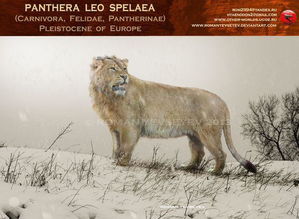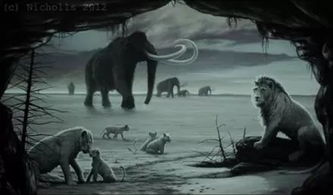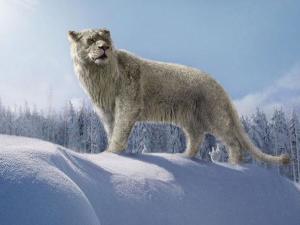
Panthera leo spelaea: The Enigmatic Cave Lion
Have you ever wondered about the mysterious creature known as the cave lion? This article delves into the fascinating world of the Panthera leo spelaea, providing a comprehensive overview of its characteristics, habitat, and the intriguing mysteries surrounding its existence.
Physical Description

The cave lion, also known as the European lion, was a subspecies of the lion that roamed the Pleistocene epoch. With a robust and muscular build, it was slightly larger than its modern-day counterpart. On average, males stood about 3.3 feet (1 meter) at the shoulder and weighed around 330 pounds (150 kilograms), while females were slightly smaller. Their fur was thick and dense, with a golden-brown color, and they had a distinctive mane that was more prominent in males.
Habitat and Distribution

The cave lion inhabited a vast range across Europe, from the British Isles to the Iberian Peninsula, and from the Mediterranean coast to the Arctic Circle. They thrived in a variety of environments, including forests, grasslands, and steppes. Their habitat was characterized by abundant prey, such as mammoths, woolly rhinoceroses, and reindeer, which provided a rich food source for these formidable predators.
| Region | Estimated Range |
|---|---|
| Europe | From the British Isles to the Iberian Peninsula, and from the Mediterranean coast to the Arctic Circle |
| Asia | From the Middle East to the Siberian tundra |
Behavior and Diet

The cave lion was a social predator, living in groups known as prides. These prides were typically composed of related females and their offspring, with a few dominant males. They were skilled hunters, using their powerful bodies and sharp claws to bring down large prey. Their diet primarily consisted of large herbivores, but they were also known to scavenge and consume carrion.
Extinction and Legacy
The cave lion became extinct around 10,000 years ago, primarily due to the rapid changes in climate and the decline of its prey species. Its extinction marked the end of the Pleistocene megafauna, a time when giant animals roamed the Earth. Despite its extinction, the cave lion continues to captivate our imagination, and its remains have provided valuable insights into the ancient world.
Conservation Efforts
While the cave lion is no longer a living species, conservation efforts are ongoing to preserve its genetic legacy. Researchers have been working on cloning the cave lion using DNA extracted from its preserved remains. This groundbreaking project aims to bring back the cave lion to life, providing a unique opportunity to study and understand this ancient creature.
Conclusion
The Panthera leo spelaea, or cave lion, remains a fascinating and enigmatic creature from the Pleistocene epoch. Its physical characteristics, habitat, and behavior provide valuable insights into the ancient world. Although it is no longer with us, the cave lion continues to captivate our imagination and inspire conservation efforts to preserve its genetic legacy.





